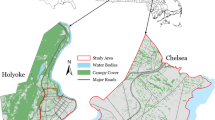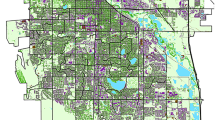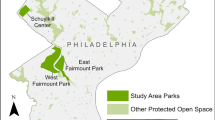Abstract
Urban forestry can benefit from improved knowledge of urbanization’s effects on tree canopy cover (TCC), a prominent urban forest indicator. This study examined changes in TCC over a long time frame, with respect to land cover (LC) changes, and across municipal boundaries. Specifically, I used air photos at 14 dates from 1937 to 2009 to develop an exceptionally long record of TCC change in Minnesota’s Twin Cities Metropolitan Area. During the study period overall TCC nearly doubled from 17% to 33% while the proportion urban land cover rose by 47%, highlighting the opportunity for substantial TCC gains following urbanization in previously agricultural landscapes, even in regions that were forested prior to European settlement. Results demonstrate that more intensely developed sites generally had lower TCC, and older urban sites had higher TCC. Modern TCC was not adequately characterized by linear distance along the urban–rural gradient, but instead peaked near the center of the gradient where mature residential neighborhoods are prevalent. Compared to other land cover changes, urbanization events caused the highest rate of immediate TCC loss (9.6% of events), yet urban areas had the second highest TCC (>35%) in 2009, indicating that urban land gained TCC relatively efficiently following development. The results of this study provide new historical context for urban forest management across an urban–rural gradient, and emphasize the need to consider ecological legacies and temporal lags following land cover changes when considering TCC goals in urban settings.






Similar content being viewed by others
Abbreviations
- ANOVA:
-
Analysis of variance
- GIS:
-
Geographic information system
- LC:
-
Land cover
- TCC:
-
Tree canopy cover
- TCMA:
-
Twin Cities Metropolitan Area
References
Akbari H (2002) Shade trees reduce building energy use and CO2 emissions from power plants. Environ Pollut 116:S119–S126
Alberti M (2005) The effects of urban patterns on ecosystem function. Int Reg Sci Rev 28:168–192
Alberti M, Susskind L (1996) Managing urban sustainability: an introduction to the special issue. Environ Impact Assess Rev 16:213–221
Alvey AA (2006) Promoting and preserving biodiversity in the urban forest. Urban For Urban Green 5:195–201
Alig RJ, Kline JD, Lichtenstein M (2004) Urbanization on the US landscape: looking ahead in the 21st century. Landsc Urban Plan 69:219–234
Arnberger A (2006) Recreation use of urban forest: at inter-area comparison. Urban For Urban Green 4:135–144
Bauer M, Heinert N, Doyle J, Yuan F (2004) Impervious surface mapping and change monitoring using satellite remote sensing. Proceedings of the American Society of Photogrammetry and Remote Sensing Annual Conference, May 24–28, 2004. 10pp
Boone CG, Cadenasso ML, Grove JM, Schwarz K, Buckley GL (2010) Landscape, vegetation characteristics, and group identity in an urban and suburban watershed: why the 60 s matter. Urban Ecosyst 13:255–271
Congalton RG, Mead RA (1983) A quantitative method to test for consistency and correctness in photointerpretation. Photogramm Eng Remote Sens 49:69–74
Conway TM, Urbani L (2007) Variations in municipal urban forest policies: a case study of Toronto, Canada. Urban For Urban Green 6:181–192
Dwyer JF, McPherson EG, Schroeder HW, Rowntree RA (1992) Assessing the benefits and costs of the urban forest. J Arboric 18:227–234
Grove JM, Troy AR, O’Neil-Dunne JP, Burch WR, Cadenasso ML, Pickett STA (2006) Characterization of households and its implications for the vegetation of urban ecosystems. Ecosyst 9:578–597
Hardin PJ, Jensen RR (2007) The effect of urban leaf area on summertime urban surface kinetic temperatures: a Terre Haute case study. Urban For Urban Green 6:63–72
Hutyra LR, Yoon B, Alberti M (2011) Terrestrial carbon stocks across a gradient of urbanization: a study of the Seattle, WA region. Glob Chang Biol 17:783–797
Luck M, Wu J (2002) A gradient analysis of urban landscape pattern: a case study from the Phoenix metropolitan region, Arizona, USA. Landsc Ecol 17:327–339
Marschner FJ (1974) The original vegetation of Minnesota (map). US Forest Service, North Central Forest Experiment Station, Saint Paul, MN
McDonnell MJ, Pickett STA (1990) Ecosystem structure and function along urban–rural gradients: an unexploited opportunity for ecology. Ecol 71:1232–1237
McDonnell MJ, Pickett STA, Groffman P, Bohlen P, Pouyat RV, Zipperer WC, Parmelee RW, Carreiro MM, Medley K (1997) Ecosystem processes along an urban-to-rural gradient. Urban Ecosyst 1:21–36
McDonnell MJ, Hahs AK (2008) The use of gradient analysis studies in advancing our understanding of the ecology of urbanizing landscapes: current status and future directions. Landsc Ecol 23:1143–1155
McPherson EG, Nowak D, Heisler G, Grimmond S, Souch C, Grant R, Rowntree R (1997) Quantifying urban forest structure, function, and value: the Chicago Urban Forest Climate Project. Urban Ecosyst 1:49–61
McPherson EG, Simpson JR (2002) A comparison of municipal forest benefits and costs in Modesto and Santa Monica, California, USA. Urban For Urban Green 1:61–74
McPherson G, Simpson JR, Peper PJ, Maco SE, Xiao Q (2005) Municipal forest benefits and costs in five US cities. J For 103:411–416
McPherson EG, Simpson JR, Xiao Q, Wu C (2011) Million trees Los Angeles canopy cover and benefit assessment. Landsc Urban Plan 99:40–50
Medley KE, McDonnell MJ, Pickett STA (1995) Forest-landscape structure along an urban-to-rural gradient. Prof Geogr 47:159–168
Nowak DJ (1993) Historical vegetation change in Oakland and its implications for urban forest management. J Arboric 19:313–319
Nowak DJ, Rowntree RA, McPherson EG, Sisinni SM, Kerkmann ER, Stevens JC (1996) Measuring and analyzing urban tree cover. Landsc Urban Plan 36:49–57
Nowak DJ, Noble MH, Sisinni SM, Dwyer JF (2001) People & trees: assessing the US urban forest resource. J For 99:37–42
Nowak DJ, Crane DE, Dwyer JF (2002) Compensatory value of urban trees in the United States. J Arboric 28:194–199
Nowak DJ, Crane DE, Stevens JC (2006) Air pollution removal by urban trees and shrubs in the United States. Urban For Urban Green 4:115–123
Rowntree RA (1984a) Ecology of the urban forest—introduction to part 1. Urban Ecol 8:1–11
Rowntree RA (1984b) Forest canopy cover and land use in four eastern United States cities. Urban Ecol 8:55–67
Tratalos J, Fuller RA, Warren PH, Davies RG, Gaston KJ (2007) Urban form, biodiversity potential and ecosystem services. Landsc Urban Plan 83:308–317
Tyrväinen L, Miettinen A (2000) Property prices and urban forest amenities. J Environ Econ Manag 39:205–223
UN Population Fund (2007) State of world population 2007: unleashing the potential of urban growth. UNFPA, New York
US Mayors (2008) Protecting and developing the urban tree canopy: a 135-city survey. The United States Conference of Mayors, Washington, D.C
Walton JT, Nowak DJ, Greenfield EJ (2008) Assessing urban forest canopy cover using airborne or satellite imagery. Arboric Urban For 34:334–340
Wu J (2008) Making the case for landscape ecology: an effective approach to urban sustainability. Landsc J 27:41–50
Acknowledgements
Air photos were obtained from the Minnesota Geospatial Information Office (http://www.mngeo.state.mn.us/) and the University of Minnesota’s John R. Borchert Map Library (http://map.lib.umn.edu/mhapo/index.html). Impervious surface data were obtained from the University of Minnesota’s Remote Sensing and Geospatial Analysis Laboratory (http://land.umn.edu/). All websites remain accessible as of 22 June 2011. Thanks to Steve Manson for helpful comments on the manuscript. The research was supported by the University of Minnesota’s Doctoral Dissertation Fellowship.
Author information
Authors and Affiliations
Corresponding author
Rights and permissions
About this article
Cite this article
Berland, A. Long-term urbanization effects on tree canopy cover along an urban–rural gradient. Urban Ecosyst 15, 721–738 (2012). https://doi.org/10.1007/s11252-012-0224-9
Published:
Issue Date:
DOI: https://doi.org/10.1007/s11252-012-0224-9




